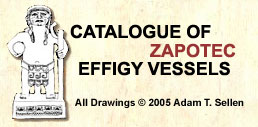| Key: MNA 6-2108 |
| Actual Location: Previously at the Museum of Cultures of Oaxaca. |
| Collection: José Juan Canseco 1853; Manuel Ortega Reyes 1860; Museum of Oaxaca. |
| Registration: 6-2108; 11290 |
| Provenance: Ejutla (Martínez Gracida 1910: plate 102-3); Hacienda of San Isidro, Xoxo (Seler circa 1888). |
| Measurements: más de 60 cm. |
| Color: Green, red, yellow and light blue. |
| Chronology: MA IIIB (Boos 1966b: 388); Xoo 600-800 AD |
| Click to view Chronology |
| Reference: Drawing in Müller 1998 [1864]: 82; drawing by Seler 1889; Photo: shelf at the Museum of Oaxaca, circa 1900, in Jesús Galindo and Villa 1905: plate 19; Boos 1966b: 388, fig. 359 (photo attributed to Marshall H. Saville). |
| Comments: Two provenances have been reported for this piece: Xoxocotlán and Ejutla, and the most reliable one is the latter, reported by Martínez Gracida (1910: unpublished) (see: Sellen, The Lost Drummer... 2005). The human figure carries on his back a large pot decorated with beads that could represent a drum. Thanks to a drawing by Edward Seler (Ibero-American Institute) and a description by Paso and Troncoso (1893), it was possible to reconstitute the object's original colors that today are no longer visible to the naked eye. Many forgeries have been inspired by this artifact, dating from around 1915. |
| Glyphs: The figure wears glyph G "deer", unfolded, as headdress (see Sellen 2005). |
|
